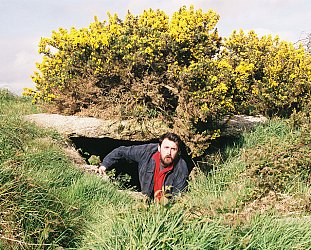Graham Reid | | 5 min read
.JPG)
When I was in bands your options for recording your music were to fund it yourself or to keep rolling the grant application dice. But these days you can get the internet to pay you to be creative.
Anika Moa got $43K from the internet for Songs For Bubbas 2 in exchange for promising CDs and a few beers, and Jan Hellriegel got $10K to work on her new album Sportsman of the Year – without even promising any rewards. Currently ex-Bachelorette Annabel Alpers looks on track to reach her $11K target on Kickstarter for forthcoming album Remote.
Running a crowdfunding campaign is a bit like following the ‘law of attraction’ from self-help book The Secret. You put your project out into the universe, think positive thoughts and then rake in bucket-loads of cash. The secret to a successful crowdfunding campaign is The Secret… right?
Yeah… nah.
Only between thirty and forty per cent of crowdfunding projects actually meet their targets, and I bet the other 60 – 70 per cent of creators were sending out plenty of good vibes. So what can you do to increase your odds of success? I’m running a crowdfunding campaign myself at the moment, so that’s a question I’ve been giving a lot of thought to lately.
At the time of writing I’m two weeks into the four-week campaign for my children’s book, 76 per cent funded and feeling cautiously optimistic. Here are the five top things that seem to be working for me:
 1.
Project preparation
1.
Project preparation
Unless you’re running a Boosted campaign (where you can ask for money to develop a project) you’re probably going to give rewards to your backers. Those rewards will likely be copies of your project in some form (in Alpers’ case, records and CDs. In my case, books). To avoid stress for yourself and a long wait for your backers, and to help convince potential supporters that you know what you’re doing, you want to have your project as ready as possible before you launch. In my case, I’ve already written and illustrated the book and the funding is for editing, design and printing.
2.
Crowdfunding preparation
I spent months preparing my campaign. There’s useful information for creators on the PledgeMe, Boosted, Kickstarter and Indiegogo crowdfunding sites, and there’s a wealth of other information online. In the months before my campaign launched I crafted my profile, shot a video, wrote a media release, got some big backers on board and found two interns by advertising on The Big Idea. I also pledged to over 30 other projects to get a sense of what worked and what didn’t. (I only pledged an average of $5, but I couldn’t resist snapping up some rewards along the way – like this book and these bookplates.)
I
spent a lot of time debating how to set my target. Realistically I
need $20K to produce and print the hardcover book to an excellent
standard. That’s a high amount to shoot for, so I thought about
lowering the target… maybe to $12K.
But only reaching $12K would be a deal-breaker for this project. I decided to take a philosophical approach. If I didn’t get the $20K I needed, maybe I didn’t have a viable product anyway.
The day my campaign went live I held a launch party where I debuted the video and gave out goodie bags. I wasn’t going to hold a launch, but I’m glad I did – it really helped get a buzz around the project and I got halfway to my goal within the first three days. (The first and last weeks of your campaign are typically the busiest.)
On a practical level, I found Trello and DropBox really handy project management and collaboration tools. (If you’d like to know more about what I did for preparation you can visit my blog for more in-depth posts.)
3.
Being brave
I’ve been blogging about my crowdfunding journey and being as open as possible every step of the way so that my friends and followers feel part of the journey. Sharing my feelings doesn’t come naturally to me and I am really looking forward to this part being over! But I think that showing my excitement and fear about this process had made people feel more inclined to support me than if I’d presented an icy-cool veneer.
4.
Friends and family
My friends and family have been amazing at supporting my project and sharing it with their networks. If you keep your friends and family in the loop with your project, they’ll be amazing at helping you out too.

Over the years I’ve been in bands, produced plays and written fiction. So I’ve been involved with lots of projects that I would have liked to have gone viral.
But in the end, what went viral was my cat, Bruce, who has over 32,000 Facebook fans.
My book is about Bruce, who will soon join Lil Bub and Oskar the Blind Cat as internet cats with crowd-funded children’s books (a burgeoning new genre!). The majority of traffic to my Kickstarter page has come from Facebook, so I’m busy reaching out to Bruce’s fans, answering their questions and providing them with content that keeps them coming back for more.
 Can
you successfully crowdfund if you don’t have 32,000 followers?
Can
you successfully crowdfund if you don’t have 32,000 followers?
Of course!
But you do need to start showing your networks some love (see point three) months out from your campaign, and to think realistically about what your funding target will be.
You might be thinking, “Well that sounds like a shitload of bloody hard work.”
And it is.
And that’s the secret to running a successful crowdfunding campaign.
Kathryn van Beek has been a previous contributor to Elsewhere's Other Voices Other Rooms forum (see here) and is currently running a crowdfunding campaign for a children’s book about internet sensation Bruce the Cat. You can visit the Kickstarter page here.
And heeeere's Bruce . . .
Other Voices Other Rooms is an opportunity for Elsewhere readers to contribute their ideas, passions, interests and opinions about whatever takes their fancy. Elsewhere welcomes travel stories, think pieces, essays about readers' research or hobbies etc etc. Nail it in 1000 words of fewer and contact graham.reid@elsewhere.co.nz.
See here for previous contributors' work. It is wide-ranging





post a comment